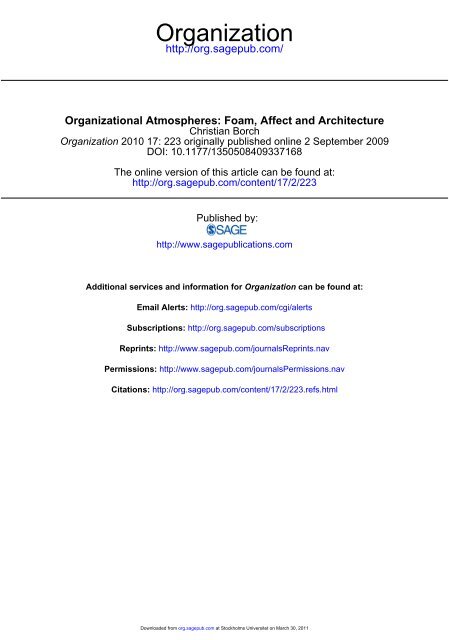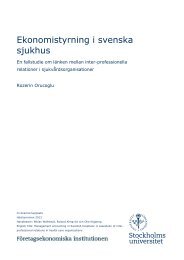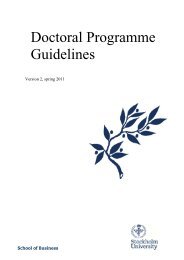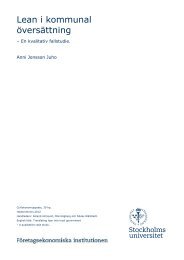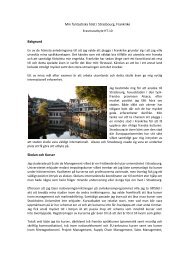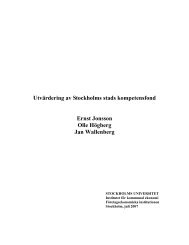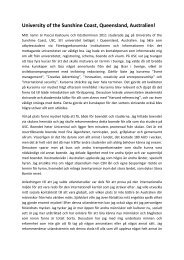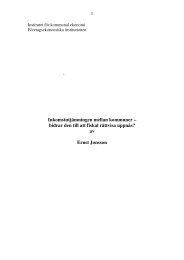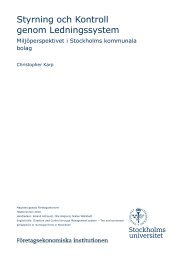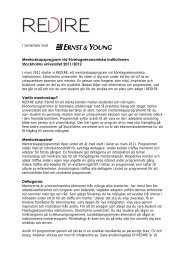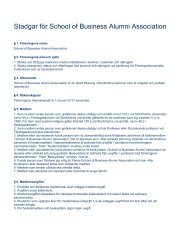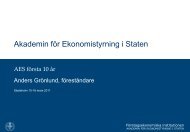Organizational Atmospheres: Foam, Affect and Architecture
Organizational Atmospheres: Foam, Affect and Architecture
Organizational Atmospheres: Foam, Affect and Architecture
Create successful ePaper yourself
Turn your PDF publications into a flip-book with our unique Google optimized e-Paper software.
Organization<br />
http://org.sagepub.com/<br />
<strong>Organizational</strong> <strong>Atmospheres</strong>: <strong>Foam</strong>, <strong>Affect</strong> <strong>and</strong> <strong>Architecture</strong><br />
Christian Borch<br />
Organization 2010 17: 223 originally published online 2 September 2009<br />
DOI: 10.1177/1350508409337168<br />
The online version of this article can be found at:<br />
http://org.sagepub.com/content/17/2/223<br />
Published by:<br />
http://www.sagepublications.com<br />
Additional services <strong>and</strong> information for Organization can be found at:<br />
Email Alerts: http://org.sagepub.com/cgi/alerts<br />
Subscriptions: http://org.sagepub.com/subscriptions<br />
Reprints: http://www.sagepub.com/journalsReprints.nav<br />
Permissions: http://www.sagepub.com/journalsPermissions.nav<br />
Citations: http://org.sagepub.com/content/17/2/223.refs.html<br />
Downloaded from<br />
org.sagepub.com at Stockholms Universitet on March 30, 2011
<strong>Organizational</strong> <strong>Atmospheres</strong>:<br />
<strong>Foam</strong>, <strong>Affect</strong> <strong>and</strong> <strong>Architecture</strong><br />
Christian Borch<br />
Volume 17(2): 223–241<br />
ISSN 1350–5084<br />
Copyright © The Author(s), 2009.<br />
Reprints <strong>and</strong> permissions:<br />
http://www.sagepub.co.uk/journalsPermissions.nav<br />
Department of Management, Politics <strong>and</strong> Philosophy, Copenhagen Business<br />
School, Frederiksberg, Denmark<br />
Abstract. This article discusses the contribution of Peter Sloterdijk’s<br />
theory of spheres to organization theory. Specifically, I apply Sloterdijk’s<br />
sphereological notion of foam to obtain a new perspective on organizations.<br />
It is argued that a foam-theoretical approach provides a simultaneous<br />
focus on organizational dynamics of affective imitation, on the spatial <strong>and</strong><br />
architectural dimensions of organizations <strong>and</strong>, finally, on the politics of<br />
organizational atmospheres. The article opens with a brief introduction<br />
to Sloterdijk’s sphere theory <strong>and</strong> then proceeds by applying his notion<br />
of foam to organizations. This includes a comparison between the foamtheoretical<br />
angle <strong>and</strong> existing perspectives in organization theory. Next I<br />
discuss Sloterdijk’s analyses of the spatiality of foam. In the final part of<br />
the article, I argue for taking seriously the politics <strong>and</strong> management of<br />
organizational atmospheres. Key words. affect; architecture; atmosphere;<br />
foam; Gabriel Tarde; imitation; organizations; Peter Sloterdijk<br />
In the past decade a growing interest has emerged in the spatial <strong>and</strong><br />
architectural dimensions of organizational life. Seminal work in this field<br />
has pointed to intimate links between generative building <strong>and</strong> organizing<br />
(Kornberger <strong>and</strong> Clegg, 2004); to how the design of workspaces is used to<br />
attract valuable workers (Duffy, 1997); as well as to the general interrelations<br />
between material space <strong>and</strong> organization (Dale <strong>and</strong> Burrell, 2008).<br />
These examples represent only a tiny fraction of the important work that<br />
has recently been conducted on the spatial <strong>and</strong> architectural aspects of<br />
DOI: 10.1177/1350508409337168 http://org.sagepub.com<br />
Downloaded from<br />
org.sagepub.com at Stockholms Universitet on March 30, 2011
Organization 17(2)<br />
Articles<br />
organizations (further discussions include Dale, 2005; Weick, 2003). The<br />
aim of this article is not to review or discuss this literature but rather to add a<br />
supplementary layer to it. I do so by applying the German philosopher<br />
Peter Sloterdijk’s theory of spheres in organization studies. 1 The basic<br />
claim of the article is that Sloterdijk’s work offers a valuable contribution to<br />
organization theory by pointing to the need for analysing the ‘politics of<br />
atmospheres’ in organizations. This means that we should not merely<br />
look at how organizations are structured spatially <strong>and</strong> architecturally; we<br />
should also examine how affective atmospheres are created <strong>and</strong> how the<br />
affective states are transmitted in the organization.<br />
According to Sloterdijk, humans live in spheres which give them meaning<br />
<strong>and</strong> provide them with a protective membrane. Sloterdijk analyses three<br />
key spheres that he names bubbles, globes <strong>and</strong> foams. Common to the the-<br />
oretical observations of these spheres is the focus on air conditions or<br />
atmospheres broadly understood, i.e. the external <strong>and</strong> spatial conditions for<br />
our being-together. This article pays primary attention to the sphere of foam.<br />
Specifically, I show how organizations may be analysed as social foam<br />
structures. The main argument of the article is that such a perspective is<br />
pertinent to organization theory in that it unites an investigation of: (1)<br />
organizational dynamics of affective imitation; (2) the spatial <strong>and</strong> architectural<br />
dimensions of organizations <strong>and</strong> (3) the politics of organizational<br />
atmospheres.<br />
The article has four parts. It begins with a brief presentation of Sloterdijk’s<br />
theory of spheres. The second part of the article outlines five general implications<br />
of analysing organizations as social foam. This part also compares<br />
the foam perspective to established positions within organization theory<br />
(e.g. DiMaggio <strong>and</strong> Powell <strong>and</strong> Luhmann). In the third part, I examine the<br />
spatial <strong>and</strong> architectural aspects of foam, as Sloterdijk describes them.<br />
Finally, the fourth part demonstrates how the focus on space <strong>and</strong> architecture<br />
can be linked to foam theory’s focus on affective imitation. This<br />
results in the call for taking seriously the politics of organizational atmospheres,<br />
including the management of these atmospheres. As this outline<br />
indicates, the article pursues a theoretical research agenda; it is beyond<br />
the scope of this article to offer a specific analysis of organizational foam.<br />
Sloterdijk’s Theory of Spheres<br />
Peter Sloterdijk (born 1947) is one of the leading contemporary German<br />
philosophers. His major breakthrough was the Critique of Cynical Reason<br />
(1988) which became a bestseller in Germany in the mid-1980s. This book<br />
is one of his few works that has been translated into English. The fact<br />
that a great part of Sloterdijk’s more than 30 books remains unavailable<br />
in English has curbed the international recognition of his work. However,<br />
in recent years his trilogy on spheres, Sphären I–III (1998–2004), has<br />
attracted significant international attention <strong>and</strong> has been translated into<br />
French <strong>and</strong> Spanish. One of the scholars who rates Sloterdijk’s work very<br />
224<br />
Downloaded from<br />
org.sagepub.com at Stockholms Universitet on March 30, 2011
<strong>Organizational</strong> <strong>Atmospheres</strong><br />
Christian Borch<br />
highly is Bruno Latour who celebrates the sphere project for its attentiveness<br />
to ‘air conditions’ <strong>and</strong> atmospheres (to be explained below).<br />
The aim of Sloterdijk’s sphereological project is to provide a new vocab-<br />
ulary of our being-together which takes into account the spatial embeddedness<br />
of the social. This spatial dimension is one indication of how<br />
Sloterdijk’s anthropology <strong>and</strong> phenomenology of spheres differs from<br />
Heidegger’s concept of being-in-the-world, for in Sloterdijk being is always<br />
being-in-a-sphere, i.e. being in some spatial setting. Latour has summarized<br />
Sloterdijk’s fundamental inquiry in the following way: ‘what does it mean to<br />
be “in” some place? It always means being inside some sphere, (some atmo-<br />
sphere)’ (Latour, 2006: 106). Sloterdijk defines his key concept of spheres<br />
as ‘the inside-like, accessed, shared circle [Runde] that humans inhabit<br />
to the extent that they succeed in becoming human beings’ (1998: 28).<br />
These spheres take various forms which Sloterdijk analyses in his trilogy,<br />
Sphären I–III. I do not wish to engage in an extensive discussion of these<br />
volumes here but will limit myself to a few general remarks.<br />
The three volumes are organized along temporal lines <strong>and</strong> according<br />
to scale. Thus, the first volume is concerned with micro-spheres, named<br />
bubbles (Sloterdijk, 1998). A bubble is a so-called ‘dyadic space of resonance<br />
between people as we find it in symbiotic relations—mother <strong>and</strong> child,<br />
Philemon <strong>and</strong> Baucis, psychoanalyst <strong>and</strong> analysed, mystics <strong>and</strong> God, etc.’<br />
(Sloterdijk in Funcke, 2005). While this first volume operates on the level<br />
of the co-subjectivity of the couple or pair, the second volume jumps to<br />
the level of macro-spheres in that it focuses on globes (Sloterdijk, 1999). It<br />
is not only the scale that changes, so does the temporal horizon. Whereas<br />
the theory of bubbles presents a primordial or ‘arch-history’ (Sloterdijk,<br />
2005: 224), the second volume embarks on a history of globalization, in the<br />
specific sense that it investigates how, from the ancient Greeks onward,<br />
the ball, the sphaira, constituted the main image in the cosmologicaltheological<br />
world-view. More concretely, this part of the sphere project<br />
examines how social reality was long conceived as one sphere, namely,<br />
as a theological <strong>and</strong> cosmological order which provided meaning to <strong>and</strong><br />
protection of life. Yet the history of the mono-spherical globe also studies<br />
the demise of this order which followed as a result of the death of God.<br />
Despite the fact that much attention is currently devoted to globalization,<br />
Sloterdijk therefore argues that the underlying mono-spherical idea behind<br />
this notion is no longer useful. Quite the opposite, the mono-spherical<br />
image has entered a state of crisis; it is not possible any more to designate<br />
one single sphere which unites <strong>and</strong> protects us.<br />
The implosion of the mono-spherical globe leads to a new spherical<br />
reality: the emergence of a plurality of spheres which Sloterdijk captures<br />
with the notion of foam, <strong>and</strong> which he analyses in the third volume of his<br />
trilogy. Since, for Sloterdijk, foam describes our present historical situ-<br />
ation, this is also the part of his sphere theory that I devote most attention<br />
to in this article. <strong>Foam</strong> is defined by Sloterdijk as ‘co-isolated associations’<br />
or, following the American architectural group Morphosis, as ‘connected<br />
225<br />
Downloaded from<br />
org.sagepub.com at Stockholms Universitet on March 30, 2011
Organization 17(2)<br />
Articles<br />
isolations’ (2004a: 302, 255). These definitions are better understood if<br />
the physical substance of foam is considered since this constitutes the<br />
intuitional base of Sloterdijk’s analysis. ‘From a physical perspective,<br />
[foam] describes multichamber systems consisting of spaces formed by<br />
gas pressure <strong>and</strong> surface tensions, which restrict <strong>and</strong> deform one another<br />
according to fairly strict geometric laws’ (Sloterdijk in Funcke, 2005). It<br />
is this multichamber organization that is referred to with the notion of<br />
co-isolated associations: each chamber or cell makes up its own microspherical<br />
world; it is separated from other chambers, but since adjacent<br />
cells share the same wall or boundary, they are characterized by cofragility,<br />
as the dissolution of one cell will affect its neighbouring cells. 2<br />
The reference to co-fragility is an indication of the importance Sloterdijk<br />
attributes to immunity production. The wall of the cell offers protection<br />
against the outside world, <strong>and</strong> its maintenance is therefore of vital import<br />
to the preservation of the cell. This leads to an appreciation of the spatial<br />
conditions of existence; in the words of Sloterdijk, it obliges us to take<br />
seriously <strong>and</strong> make explicit the ‘air conditions’ of foam (2004a).<br />
Since foam designates the association of co-isolated cells, a conceptual<br />
framework is needed to describe this relatedness. According to Sloterdijk,<br />
‘[i]n social foam there is no “communication” … but instead only interautistic<br />
<strong>and</strong> mimetic relations’ (Sloterdijk in Funcke, 2005). This move<br />
from communication theory to imitation theory is instigated by Sloterdijk’s<br />
interest in Gabriel Tarde’s sociology. Tarde developed a gr<strong>and</strong> sociological<br />
theory based on the assertion that ‘[s]ociety is imitation <strong>and</strong> imitation is a<br />
kind of somnambulism’ (Tarde, 1962: 87; italics in original). Specifically,<br />
Tarde described how ideas, gestures, fashions, etc. transfer through imitative<br />
rays, <strong>and</strong> how these imitations take the form of hypnotic relations<br />
where the one who imitates may think that he or she acts spontaneously,<br />
but actually only reacts to hypnotic suggestions. This underst<strong>and</strong>ing of<br />
somnambulistic imitation resonates well with Sloterdijk’s notion of the<br />
co-subjectivity of micro-spherical bubbles, but as said, it also constitutes<br />
the key relational dynamic between foam cells: the cells do not affect one<br />
another through direct exchange, but rather through ‘mimetic infiltration’ <strong>and</strong><br />
‘contagion’ (2004a: 61, 259). I will return to the imitative aspect below.<br />
Sloterdijk argues that the notion of social foam should replace that of<br />
society. The latter category is unsatisfactory, he believes, as it connotes too<br />
strongly that the social is a ‘mono-spherical container’ (2004a: 59). Contrary<br />
to that image, the notion of foam points to<br />
an aggregate of micro-spheres (couples, households, companies, associations)<br />
of different formats that are adjacent to one another like individual bubbles<br />
in a mound of foam <strong>and</strong> are structured one layer over/under the other, without<br />
really being accessible to or separable from one another. (2004a: 59)<br />
I am aware that this brief outline of Sloterdijk’s sphere project may leave<br />
the reader with the impression that this is all just speculative philosophy.<br />
Sloterdijk does admit that some parts of the trilogy are ‘written in a strange<br />
226<br />
Downloaded from<br />
org.sagepub.com at Stockholms Universitet on March 30, 2011
<strong>Organizational</strong> <strong>Atmospheres</strong><br />
Christian Borch<br />
language’ (2005: 224). But this is intended since he believes that a new<br />
vocabulary is needed to account for social life. In the following parts of<br />
the article I seek to explore how organization theory may profit from this<br />
new language. I do so by analysing organizations as foam.<br />
<strong>Organizational</strong> <strong>Foam</strong><br />
How <strong>and</strong> with what implications may the sphere theory be applied to<br />
organizations? As the above quote indicates, Sloterdijk seems to conceive<br />
of organizations as micro-spherical bubbles that are part of the overall social<br />
foam. In my opinion, reducing organizations to singular bubbles underestimates<br />
their complexity. I will argue instead that each organization<br />
itself composes a foam structure with many bubbles or cells. This is not to<br />
suggest a fractal logic where each part mimes the whole (meaning in our<br />
case that each bubble is a foam of bubbles). Rather, the aim is to take seriously<br />
the complex nature of organizations <strong>and</strong> this requires that they are<br />
seen as foam composites.<br />
What do we get to see if we observe organizations as foam? I claim that<br />
a foam-theoretical view on organizations entails a unique combination of<br />
five dimensions. It is crucial to stress that, while each of the five dimensions<br />
may be found in various branches of existing organization theory,<br />
the significance of Sloterdijk’s work lies precisely in providing a theoretical<br />
vocabulary that integrates these dimensions <strong>and</strong> relates them to<br />
one another. What, then, are these dimensions? First, foam theory implies<br />
that we see organizations as complex composites that have no real centre.<br />
In foam, whether as physical substance or social entity, there is no core<br />
from which other bubbles emerge or to which they need relate. Rather,<br />
since no bubble is per definition more important than others, new bubbles<br />
may emerge from any part of the foam structure. Consequently, a foamtheoretical<br />
approach does not observe organizations from the view point of<br />
hierarchies, in terms of principal-agent relations or the like, but focuses,<br />
on the contrary, on how organizational sociality creates a foam structure<br />
of co-isolated bubbles where no cell has primacy. These cells or bubbles<br />
emerge as soon as a membrane has been created that provides meaning <strong>and</strong><br />
immunity to those who are surrounded by it. For example, individual offices<br />
or the various divisions of an organization may count as such bubbles.<br />
Second, since foam is at the centre of attention, the individual subjects<br />
<strong>and</strong> their capacities, interests <strong>and</strong> motives are not the analytical starting<br />
point. Third, it follows from the foam-theoretical perspective that the cells<br />
do not pursue some overall <strong>and</strong> common organizational goal. Rather, they<br />
are concerned with their own immunity strategies, i.e. strategies for preserving<br />
the fragile membrane of the cell. An example of such immunity<br />
strategies could be the ways in which employees use ‘hot nesting’ (Warren,<br />
2006) to create minor bubbles in the organization that imitate the domestic<br />
sphere <strong>and</strong> its safety <strong>and</strong> comfort (see also Dale <strong>and</strong> Burrell, 2008: 119).<br />
227<br />
Downloaded from<br />
org.sagepub.com at Stockholms Universitet on March 30, 2011
Organization 17(2)<br />
Articles<br />
Fourth, the foam theory does not say much about the internal workings of<br />
the cells. They generate small worlds of their own <strong>and</strong> operate according to<br />
internal logics, but other than this, the inner organization is not really explored<br />
in foam theory. Instead it focuses on the relations between cells <strong>and</strong><br />
these relations are, as mentioned above, described in terms of imitation<br />
<strong>and</strong> contagion. This also means that in foam theory, organizations are not<br />
analysed as entities that are based on specific operations, as for example<br />
Luhmann (2000) claims in his analysis of organizational decisions. The<br />
organizational connectedness is created instead via the imitations. Finally,<br />
as a fifth contribution to organization theory, the foam theory explicitly<br />
addresses spatiality <strong>and</strong> architecture. This includes, as I shall discuss in<br />
the following sections of the article, an attentiveness to organizational<br />
atmospheres <strong>and</strong> their management.<br />
As mentioned above, these five dimensions may seem to resemble what<br />
is already observed by existing perspectives in organization theory. This<br />
includes, for example, the emphasis on imitation which is shared by the<br />
institutionalism of DiMaggio <strong>and</strong> Powell. Yet the foam-theoretical per-<br />
spective nevertheless has a different accent on these dimensions, as I will<br />
now show by discussing in more detail how <strong>and</strong> to what extent the five<br />
dimensions differ from established ideas in organization theory. First, the<br />
a-centric view on organizations that foam theory offers can also be found<br />
in network analyses. In spite of theoretical similarities regarding the critique<br />
of hierarchies, Sloterdijk is at great pains to stress the conceptual dif-<br />
ference between the notions of foam <strong>and</strong> network. This difference touches<br />
upon the spatial dimension that is central to the sphere theory <strong>and</strong> which<br />
is integrated in the image of foam (e.g. soap bubbles in the bathtub). The<br />
spatial connotations of the foam concept are, Sloterdijk believes, a significant<br />
advantage of foam theory as compared to network theory, including<br />
its organizational variants. According to Sloterdijk, the network concept<br />
expresses an<br />
excessively reductive geometry: Instead of emphasizing the intrinsic spatial<br />
properties of the communicating actors to be related to one another, the<br />
image of the network intimates the notion of exp<strong>and</strong>ed points that are connected<br />
qua interfaces for lines—a universe for data trawlers <strong>and</strong> anorectics.<br />
(2004a: 257)<br />
Contrary to this anorectic <strong>and</strong> a-spatial image, the foam metaphor points<br />
explicitly to the spatial extension of the individual cells (Sloterdijk,<br />
2004b: 21).<br />
One may argue that combining an a-centric view on organizations with<br />
a spatial awareness brings Sloterdijk close to organization theories that<br />
draw on a Deleuzian perspective (e.g. Sørensen, 2005). Indeed, Sloterdijk<br />
applauds Deleuze <strong>and</strong> Guattari for attributing great importance to space<br />
in their Thous<strong>and</strong> Plateaus (Deleuze <strong>and</strong> Guattari, 1987; Sloterdijk in<br />
Funcke, 2005). Other similarities between Deleuze <strong>and</strong> Sloterdijk regard<br />
the joint vitalist impulse <strong>and</strong> their common inspiration from Tarde (in<br />
228<br />
Downloaded from<br />
org.sagepub.com at Stockholms Universitet on March 30, 2011
<strong>Organizational</strong> <strong>Atmospheres</strong><br />
Christian Borch<br />
Deleuze’s case, see Alliez, 2004). However, Sloterdijk’s foam theory has a<br />
much greater emphasis on Tardean imitation dynamics than Deleuze who<br />
is more interested in Tarde’s focus on beliefs <strong>and</strong> desires (Deleuze <strong>and</strong><br />
Guattari, 1987: 219). Although imitation <strong>and</strong> beliefs <strong>and</strong> desires are closely<br />
interrelated in Tarde, this inspirational difference has implications for the<br />
interpretation of organizational behaviour. Thus Deleuze-inspired work is<br />
likely to emphasize desire (Sørensen, 2005), whereas a foam-theoretical<br />
view on organizations has as a major concern the role of imitation. 3<br />
The emphasis on spatiality (<strong>and</strong> thereby the fifth dimension listed above)<br />
is also one of the points where the foam theory differs from, in particular,<br />
Niklas Luhmann’s work. According to Luhmann, social systems, including<br />
organizations, have communicative boundaries rather than spatial bound-<br />
aries (Luhmann, 1997: 76). It is this a-spatial conception of organizations<br />
that Sloterdijk’s foam theory avoids (not least by emphasizing the significance<br />
of atmospheres, thereby attributing greater importance to the environment<br />
than Luhmann does in his systems theory).<br />
Before investigating the spatial aspects of foam, however, I wish to look<br />
closer at the second dimension listed above, the deliberate disregard of the<br />
individual subjects in the organization. This disregard is far from unique to<br />
foam theory. Indeed, it is shared by many post-structualist accounts. This<br />
applies, for instance, to Luhmann’s (2000) systemic sociology of organizations<br />
as well as to Foucauldian studies (e.g. Karlsen <strong>and</strong> Villadsen, 2008;<br />
Munro <strong>and</strong> R<strong>and</strong>all, 2007). The main difference between these approaches<br />
<strong>and</strong> foam theory does not regard the overall ambition of going beyond indi-<br />
vidualistic analyses, but lies rather in how this is done. Whereas both<br />
Luhmann’s systems theory <strong>and</strong> Foucualdian studies are part of the linguistic<br />
turn in social theory, which has emphasized communication <strong>and</strong> discourse<br />
rather than subjectivity, Sloterdijk’s foam theory does not attribute primary<br />
importance to communication but to imitation. As mentioned above, this<br />
move from communication to imitation relates to Sloterdijk’s inspiration<br />
from Tarde. Tarde analyses imitation as a kind of somnambulistic suggestion<br />
<strong>and</strong> thereby points to its hypnotic <strong>and</strong> contagious-affective foundation.<br />
It is this notion of suggestion, or imitation-suggestion, which, I claim,<br />
is key to underst<strong>and</strong>ing foam sociality, <strong>and</strong> hence organizations. 4 One of<br />
the major implications of suggestion is that it undermines the notion of<br />
individuality. The individual <strong>and</strong> his or her desires, inclinations, gestures,<br />
etc., are seen as hypnotically transmitted <strong>and</strong> therefore not specific or characteristic<br />
to the individual in question. Indeed, in Tarde’s sociology, the<br />
individual is nothing but the ‘container’ or agglomeration of various rays of<br />
imitations, some of which may be in conflict with one another. Ruth Leys<br />
has put it this way:<br />
By dissolving the boundaries between self <strong>and</strong> other, the theory of imitationsuggestion<br />
embodied a highly plastic notion of the human subject that radically<br />
called into question the unity <strong>and</strong> identity of the self. Put another way, it made<br />
the notion of individuality itself problematic. (Leys, 1993: 281)<br />
229<br />
Downloaded from<br />
org.sagepub.com at Stockholms Universitet on March 30, 2011
Organization 17(2)<br />
Articles<br />
The suspension of <strong>and</strong> attack on individuality, which is implied by the<br />
notion of imitation-suggestion, is shared by Sloterdijk. He conceives of the<br />
sphereology as a critique of the primacy often attributed to singular<br />
individuals <strong>and</strong> sees himself as ‘an intransigent critic of individualism’<br />
(2005: 236).<br />
The emphasis on imitation is also central to the fourth dimension mentioned<br />
above. Again, the reference to imitation dynamics is not new to<br />
organization theory, so how does Sloterdijk’s Tardean conception differ<br />
from, say, DiMaggio <strong>and</strong> Powell’s notion of mimetic isomorphism<br />
(DiMaggio, 1983; DiMaggio <strong>and</strong> Powell, 1991)? DiMaggio <strong>and</strong> Powell<br />
distinguish between three types of institutional isomorphism, namely,<br />
coercive, mimetic <strong>and</strong> normative. Imitation or mimetic isomorphism is said<br />
to be a response to uncertainty, for example, ‘when goals are ambiguous, or<br />
when the environment creates symbolic uncertainty’ (1991: 69). According<br />
to this perspective, imitation only constitutes one part of organizational<br />
behaviour, <strong>and</strong> one which is ‘employed in order to make difficult decisions’<br />
(DiMaggio, 1983: 158). Contrary to this underst<strong>and</strong>ing, Tarde does not<br />
reduce imitation to being merely one of several forms of social or organizational<br />
behaviour; rather, he claims that imitation is constitutive of the<br />
social. All organizational behaviour can be analysed in terms of imitation.<br />
Furthermore, imitation is not a response to something in or outside the<br />
organization, but carries its own impetus (see Sahlin-Andersson <strong>and</strong><br />
Sevón, 2003: 253). Hence, as Barbara Czarniawska has explained in a dis-<br />
cussion of Tarde’s contribution to organization theory, where she compares<br />
his work to that of DiMaggio <strong>and</strong> Powell, ‘[i]imitation is not a residual<br />
category, but a pivotal explanatory concept for those who try to underst<strong>and</strong><br />
the phenomena of contemporary world of organizations’ (2004: 121). Inter-<br />
preting organizations as foam thus implies that imitation is not one<br />
mechanism of isomorphism among others, but the very mechanism of<br />
organizational behaviour.<br />
I leaped over the third dimension, that foam cells do not pursue an overall<br />
organizational goal. This observation is also to be found in much organ-<br />
ization theory. For example, Luhmann’s classic study of Funktionen und<br />
Folgen formaler Organisation takes as one of its main starting points the<br />
observation that organizations are not constituted by common goals<br />
(Luhmann, 1964). In Sloterdijk’s foam theory the pursuit of sub-goals is<br />
explained by the vitalism of the individual foam cells. It is claimed, in other<br />
words, that far from being a narrow pursuit of rational sub-optimizing,<br />
the foam bubbles are possessed by an urge to maintain their life <strong>and</strong> existence<br />
(for a discussion of this foam-vitalist argument, see Borch, 2008).<br />
This vitalism might be compared to the principle of self-organization in<br />
Luhmann’s systems theory (see Lash, 2005). However, the vitalist impetus<br />
in Sloterdijk naturally emphasizes the value of life more emphatically than<br />
does Luhmann with his notion of self-organization. 5<br />
230<br />
Downloaded from<br />
org.sagepub.com at Stockholms Universitet on March 30, 2011
<strong>Organizational</strong> <strong>Atmospheres</strong><br />
Christian Borch<br />
To end this discussion, my claim is that, while each of the five dimensions<br />
listed above may be identified (at least to some extent) in established<br />
theories of organization, foam theory presents a different interpretation of<br />
each dimension. Even more important, foam theory does not pay attention<br />
merely to one or two of these dimensions, but offers a way to conceptualize<br />
all these dimensions simultaneously. Observing organizations as foam<br />
therefore means taking into account at once their a-centric nature, their<br />
immunity strategies, their imitations <strong>and</strong> their spatiality. To give but a brief<br />
illustration of how a specific organizational foam analysis could proceed,<br />
one could take as the starting point the immunity strategies of new-hires.<br />
In the novel The Mezzanine, Nicholson Baker suggests that new-hires have<br />
a higher bathroom frequency than people who have been in the organ-<br />
ization for a longer period (Baker, 1998). The reason is, speculates Baker,<br />
that ‘the corporate bathroom is the one place in the whole office where<br />
you underst<strong>and</strong> completely what is expected of you’ (1998: 71, n. 1). Paying<br />
attention to the behaviour in corporate bathrooms clearly follows an<br />
a-centric view on the organization, but it also opens up for an analysis<br />
of how the spatial atmosphere of such corporate bathrooms provide immunity<br />
<strong>and</strong> afford specific behaviours, <strong>and</strong> how the atmospheres may be<br />
transmitted imitatively to other parts of the organization, thereby affecting<br />
behaviours outside the bathrooms (which is all beautifully described in<br />
Baker’s novel).<br />
The Spatiality of <strong>Foam</strong><br />
I have claimed that in particular the spatial-architectural dimension is important<br />
to the theory of foam, <strong>and</strong> in the following I want to demonstrate<br />
in more detail how space <strong>and</strong> architecture are analysed by Sloterdijk.<br />
Since I have already pointed to the spatial connotations of the notion of<br />
foam, I will now discuss three additional ways in which foam theory<br />
addresses space <strong>and</strong> architecture. To begin with, Sloterdijk is concerned<br />
specifically with the architectural embeddedness of foam. In his book on<br />
foam, he provides fascinating analyses of a number of architectures, including<br />
dwellings, stadiums <strong>and</strong> convention centres. Particularly the latter<br />
are interesting in the present context, as they are most directly related to the<br />
organizational realm. Convention centres are of many different kinds,<br />
covering everything from huge buildings containing fairs that last for<br />
several days to small conference rooms intended for brief meetings. 6<br />
Sloterdijk finds such convention centres interesting because they signify a<br />
distinctively modern solution to the problem of how to convene or assemble<br />
in physical isolation (2004a: 646). Indeed, he believes, these buildings<br />
have a characteristically contemporary character, because they offer an<br />
architectural reflection of a society devoted to meetings (2004a: 648).<br />
Sloterdijk here presents a diagnostic interpretation of architecture,<br />
pointing to how it supports <strong>and</strong> makes possible temporary gatherings <strong>and</strong><br />
discussions among people who only assemble because of a shared topic,<br />
231<br />
Downloaded from<br />
org.sagepub.com at Stockholms Universitet on March 30, 2011
Organization 17(2)<br />
Articles<br />
not because they share a common identity. In a similar vein, he analyses<br />
modern apartments as a contemporary reflection of a society in which indi-<br />
vidualism is emphasized.<br />
The next spatial dimension of foam that I want to stress here relates to<br />
immunity. As argued above, since foam bubbles are fragile <strong>and</strong> protected<br />
by frail membranes, immunity maintenance is a crucial concern. This has<br />
a clear spatial <strong>and</strong> architectural dimension, as architecture is one way of<br />
producing immunity vis-à-vis the outside world. It is from this perspective<br />
that Sloterdijk asserts that a residence constitutes a ‘spatial immune system’<br />
(2004a: 535). And it is for similar reasons that he is preoccupied with the<br />
American designer, Richard Buckminster Fuller’s mobile architecture,<br />
for the mobility it represents allows for flexible <strong>and</strong> adaptable immunity<br />
strategies. As indicated with the corporate bathroom example, such spatial<br />
immunity may also be provided by specific organizational rooms or<br />
spaces, for example, by the shielding produced by the walls of individual<br />
offices.<br />
The most important spatial dimension, however, relates to the observation<br />
that, for Sloterdijk, all human being-together, <strong>and</strong> hence also foam<br />
sociality, is embedded in specific ‘air conditions’ or atmospheres. The significance<br />
of these socio-physical surroundings of foam are demonstrated<br />
by Sloterdijk in several original analyses. One of these traces the history of<br />
glass houses <strong>and</strong> arcades which became popular in the 19th century <strong>and</strong><br />
which were thoroughly scrutinized by Walter Benjamin in his Arcades<br />
Project (1999). According to Sloterdijk, however, 20th <strong>and</strong> 21st century<br />
developments cannot by accounted for by Benjamin’s analysis; these<br />
more recent architectural inventions of interiorized exteriors, climate<br />
control systems, etc., would require an independent Air Conditions Project<br />
(Sloterdijk, 2004a: 182). Another line of analysis, which traces the import<br />
of air conditions, takes as its starting point Jakob von Uexküll’s invention<br />
of the notion of the ‘environment’ in 1909 (2004a: 193). This notion<br />
paved the way for a serious consideration of the environmental conditions<br />
of existence of any system <strong>and</strong> hence of any life form <strong>and</strong> organization.<br />
Sloterdijk shows that this consideration has now been generalized <strong>and</strong><br />
made into a common experience: humans depend on the presence of spe-<br />
cific air conditions. This is not merely a reference to the fact that humans<br />
need air to live (although this is also implied by air conditions). It refers as<br />
well to the experience that a manipulation of the environment affects the<br />
system in question <strong>and</strong> therefore also the immunity it seeks to provide—<strong>and</strong><br />
this is the case whether the manipulation is physical or social-psychological<br />
(Sloterdijk analyses both chemical warfare via gas poising <strong>and</strong> political<br />
warfare through media propag<strong>and</strong>a, see 2004a: 89 ff., 182 ff.; see also Latour,<br />
2006). This means among other things that the foam sociality of organ-<br />
izations is affected by how the architectural design allows for specific<br />
light, odours, climate control, etc. It is this rather than the diagnostic inter-<br />
pretation that I wish to pursue in the following section where I link imitation<br />
<strong>and</strong> air conditions/atmospheres.<br />
232<br />
Downloaded from<br />
org.sagepub.com at Stockholms Universitet on March 30, 2011
<strong>Organizational</strong> <strong>Atmospheres</strong><br />
Christian Borch<br />
Architectural <strong>Atmospheres</strong>: <strong>Foam</strong> <strong>and</strong> <strong>Affect</strong><br />
It was mentioned above that Sloterdijk argues that the relation between the<br />
co-isolated foam cells is characterized by imitation dynamics <strong>and</strong> mimetic<br />
infiltration. I will now discuss this relation in more detail <strong>and</strong> associate it<br />
with the discussion of the spatiality <strong>and</strong> architecture of organizational foam.<br />
The starting point of this discussion is Sloterdijk’s own major source of<br />
inspiration, namely, Gabriel Tarde. As demonstrated previously, Tarde<br />
conceives of imitation as a kind of somnambulistic suggestion. Suggestion<br />
has two important implications in Tarde. First, it undermines the notion of<br />
individuality (this was shown above). Second, suggestion emphasizes affect<br />
rather than deliberation <strong>and</strong> conscious choices. Since the social individual,<br />
for Tarde, is akin to a sleepwalker, his or her behaviour is not a result of<br />
purposive action, but rather of ‘semiconscious suggestion’ (Borch, 2007;<br />
Williams, 1982). This means that when Sloterdijk argues that the relation<br />
between foam cells is characterized by imitation, he in fact stresses how crucial<br />
affect is to underst<strong>and</strong>ing foam sociality: the semiconscious imitationsuggestion<br />
addresses rather directly the import of affect, emotions, etc. <strong>and</strong><br />
how these <strong>and</strong> related qualities are transmitted from one cell to others. But<br />
how does this transmission take place more specifically? To answer that<br />
question, Teresa Brennan’s brilliant book on The Transmission of <strong>Affect</strong><br />
(2004) proves helpful. Indeed, I will argue, Brennan offers an important<br />
way of underst<strong>and</strong>ing the link between foam theory’s focus on imitation<br />
<strong>and</strong> the sphereological interest in atmospheres.<br />
Brennan opens the book by relating architecture <strong>and</strong> affect, asking ‘[i]s there<br />
anyone who has not, at least once, walked into a room <strong>and</strong> “felt the atmosphere”?’<br />
(2004: 1). What she claims is that this atmosphere is constituted,<br />
in part at least, by affects. To be more specific, the atmosphere is comprised<br />
by the affective state of those present, <strong>and</strong> this state can be transmitted to<br />
people who enter the room. This is what happens when you feel the atmosphere.<br />
Crucially, Brennan continues:<br />
The transmission of affect, whether it is grief, anxiety, or anger, is social or<br />
psychological in origin. But the transmission is also responsible for bodily<br />
changes; some are brief changes, as in a whiff of the room’s atmosphere, some<br />
longer lasting. In other words, the transmission of affect, if only for an instant,<br />
alters the biochemistry <strong>and</strong> neurology or the subject. The ‘atmosphere’ or the<br />
environment literally gets into the individual. (Brennan, 2004: 1)<br />
It is important to stress that no biological reductionism is at play here. Quite<br />
the contrary, the argument is that social <strong>and</strong> psychological factors generate<br />
specific biological reactions, not the other way around. 7 Further, it is interesting<br />
to note that Brennan’s discussion is aimed in part as a critique of<br />
the notion of self-contained individuality. According to Brennan, it is too<br />
often taken for granted that emotions can go ‘no farther than the skin’ of<br />
the individual person (2004: 2). But, she demonstrates, this assumption<br />
is undermined by a plentitude of studies <strong>and</strong>, indeed, by the argument<br />
on the transmission of affect. This critical perspective on self-contained<br />
233<br />
Downloaded from<br />
org.sagepub.com at Stockholms Universitet on March 30, 2011
Organization 17(2)<br />
Articles<br />
individuality places Brennan’s argument on a par with the aim of both Tarde<br />
<strong>and</strong> Sloterdijk. Similar to Tarde, Brennan discusses hypnosis <strong>and</strong> argues<br />
that this phenomenon illustrates crucial aspects of the transmission of<br />
affect (2004: 76, 184, n. 9). And akin to Sloterdijk, she comes close to a<br />
notion of co-subjectivity through affective transmission.<br />
In analysing more specifically how an atmosphere is felt <strong>and</strong> transmitted,<br />
Brennan puts great emphasis on smell, more precisely, she focuses on<br />
‘unconscious olfaction’ (2004: 9). She draws here on neurological studies<br />
of ‘entrainment’. These studies focus on so-called ‘pheromones’, which are<br />
substances that are secreted from the body <strong>and</strong> which may then affect<br />
others. To quote a recent definition that Brennan herself cites, ‘pheromones<br />
are “pollenlike chemicals that when emitted by one creature have some<br />
effect on other members of the same species”’ (2004: 69). These pheromones<br />
can be sensed in different ways, e.g. by touch, visually or by smell. As indi-<br />
cated, for Brennan, it is not least through smell that pheromones are<br />
detected. 8 ‘To smell pheromones is also in a sense to consume them. But<br />
the point here is that no direct physical contact is necessary for a transmission<br />
to take place. Pheromones are literally in the air’ (2004: 69). This<br />
is worth emphasizing: the focus on entrainment points to how one’s state<br />
of affect produces a substance that is emitted <strong>and</strong> which may then, through<br />
social interaction, be absorbed by others whereby the former’s affect is<br />
transmitted to the latter. And this can occur unconsciously; I need not<br />
recognize that I smell the pheromones, but the fact that I do smell them<br />
generates the transmission—or, in Tardean terms, the imitation—of affect.<br />
This all explains, Brennan says, that the ‘affect in the room is a profoundly<br />
social thing’ (2004: 68; italics in original). It is social interaction which<br />
stimulates the entrainment.<br />
I realize that the discussion of the transmission of affect may seem like<br />
a detour from the overall theme of this article. Yet, I believe, this discussion<br />
has been important to establish one of the key contributions of foam<br />
theory to organization theory: the ‘explicitation’, as Sloterdijk calls it, of<br />
the politics of organizational atmospheres. And as I have tried to show,<br />
Brennan’s work is in fact explicitly concerned with issues relating to<br />
Tarde’s interest in affective imitation—suggestion <strong>and</strong> Sloterdijk’s idea of<br />
the imitative infiltration of foam cells. Indeed, the observation of how affect<br />
can be transmitted through unconscious olfaction addresses Sloterdijk’s<br />
observation of the importance of spherical air conditions, or atmospheres.<br />
In short, Brennan’s work demonstrates how the affective being-in-a-sphere<br />
produces an emission-of-pheromones-in-that-sphere <strong>and</strong> that the smell of<br />
these is an important atmospheric condition of affective imitation. I will<br />
now discuss this point in more detail, <strong>and</strong> relate it to the discussion of organ-<br />
izational architecture, by examining some of the German philosopher,<br />
Gernot Böhme’s reflections on architectural atmospheres. 9<br />
In several of his works, Böhme has devoted serious attention to the import<br />
of atmospheres. <strong>Atmospheres</strong>, for Böhme, are ‘tuned spaces’ [gestimmte<br />
Räume] or ‘spatially discharged, quasi-objective feelings’ (2006: 16). This<br />
234<br />
Downloaded from<br />
org.sagepub.com at Stockholms Universitet on March 30, 2011
<strong>Organizational</strong> <strong>Atmospheres</strong><br />
Christian Borch<br />
quasi-objective part is an interesting supplement to Brennan’s argument.<br />
While she is concerned with how affect is transmitted via human interaction<br />
in, say, a room or office, Böhme stresses that the room itself produces a<br />
particular affective state, which need not be directly inter-personally transmitted.<br />
So from this perspective, the atmosphere of a room is not merely a<br />
product of the affective states of the people who are present; the very<br />
physical staging of the room itself generates affects. Precisely the staging is<br />
crucial to Böhme, as it points to the fact that affects do not simply emerge<br />
from nothing; rather they can be more or less deliberately produced <strong>and</strong><br />
formed. <strong>Architecture</strong> <strong>and</strong> architects play an active role here:<br />
Exactly architecture produces atmospheres in everything it creates. Of<br />
course, it also solves specific problems <strong>and</strong> fabricates objects <strong>and</strong> buildings<br />
of all sorts. But architecture is aesthetic work in the sense that it always<br />
also generates spaces with a special mood quality, i.e. atmospheres. … The<br />
visitor, the user, the customer, the patient are met with or seized by these<br />
atmospheres. The architect, however, creates them, more or less consciously.<br />
(Böhme, 1995: 97)<br />
Given the focus on feelings <strong>and</strong> how they are perceived, Böhme attributes<br />
great importance to how odours, lights, sounds, colours, etc. produce specific<br />
atmospheres. Akin to Brennan, he emphasizes in particular the import<br />
of smell. In a discussion of the atmosphere of cities, for example, he notes<br />
that ‘[t]he smells are a crucial element of a city’s atmosphere, perhaps<br />
even the most crucial one, for smells are atmospheric to a greater degree<br />
than other sensual phenomena’ (2006: 128). In a similar vein, the Swiss<br />
architect Peter Zumthor (whom Böhme refers to) seeks to capture the atmosphere<br />
of architecture through notions such as ‘the sound of space’ <strong>and</strong> ‘the<br />
temperature of space’ (Zumthor, 2006: 29, 33). And the Finnish architect<br />
Juhani Pallasmaa argues in a parallel manner when stressing the need for<br />
a multi-sensual conception of architecture, stating, for example, that ‘[t]he<br />
most persistent memory of any space is often its smell’ (2005: 54). As in<br />
Brennan’s case, this addresses the sphereological theme of air conditions/<br />
atmospheres <strong>and</strong> how these are integral to the question of affect.<br />
The reference to how atmospheres can be created architecturally suggests<br />
that power <strong>and</strong> management are pertinent to the foam discussion.<br />
Böhme talks of ‘aesthetic manipulation’ (1995: 48), pointing to the cap-<br />
acity of aesthetic, i.e. atmospheric, production to generate specific affective<br />
states. This manipulative capacity can be observed in both the economic<br />
<strong>and</strong> political realms. In his work on aesthetic economy, Böhme not only<br />
analyses architectural atmospheres, but also calls attention to the atmospheres<br />
of objects <strong>and</strong> things. A great part of this focuses on how, in con-<br />
temporary capitalism, goods are increasingly endowed with positive<br />
atmospheric qualities. For example, products are made to feel nice, smell<br />
good <strong>and</strong> look attractive. Böhme is, of course, not alone in observing this<br />
trend. Scholars such as Nigel Thrift have made similar observations. In a<br />
recent discussion Thrift states that, ‘[f]or some time now, there have been<br />
attempts to extend the signature of the commodity, both by enlarging its<br />
235<br />
Downloaded from<br />
org.sagepub.com at Stockholms Universitet on March 30, 2011
Organization 17(2)<br />
Articles<br />
footprint in time <strong>and</strong> by reinforcing its content, most especially by loading<br />
it with more affective features’ (2007: 38). In line with this, one may study<br />
how the organizational interiors, say, desks <strong>and</strong> chairs, are designed to<br />
create such affective attributes. 10<br />
The manipulative capacity is, as said, also identifiable in politics. Böhme<br />
analyses how NS architecture was used as a specific ‘communication<br />
design’, aiming at creating particular affects <strong>and</strong> ecstasies in the masses<br />
(2006: 152, 162–72). Sloterdijk has made similar analyses of how, in the<br />
aftermath to the French Revolution in 1789, architecture was used politically<br />
<strong>and</strong> affectively to form collectivities, <strong>and</strong> how this preconfigured subsequent<br />
fascist attempts to fabricate comparable results (Sloterdijk, 2008).<br />
In sum, Böhme’s focus on the atmospheric qualities of architecture <strong>and</strong><br />
objects urges us to study, on an organizational level, both ‘the personal productivity<br />
of atmospheres, which can induce moods more or less against a<br />
person’s will, <strong>and</strong> the targeted generability of atmospheres, based on the<br />
knowledge of the scenic functions of social goods’, as Löw has put it in a<br />
recent discussion (2008: 44–5).<br />
The work of Tarde, Brennan <strong>and</strong> Böhme points to the significance<br />
of architectural atmospheres or air conditions of organizational foam.<br />
Böhme shows that architecture (<strong>and</strong> objects) creates particular affective<br />
states <strong>and</strong> Brennan emphasizes how these affects can be transmitted to<br />
other persons, thereby creating an affective co-subjectivity. According to<br />
Sloterdijk’s Tardean conception of social foam, organizational architecture<br />
is therefore partly a crucial air condition <strong>and</strong> partly what stimulates mimetic<br />
infiltration between cells. Interestingly, the foam theory is also compatible<br />
with Böhme’s observation that architectural atmospheres may be an object<br />
for manipulation <strong>and</strong> management. Thus, Sloterdijk examines how air<br />
designs of shopping malls, clinics, convention centres, etc.—in general:<br />
organizations—aim to create affective attachments. These air designs, he<br />
says, analogously to Brennan, may not least be produced by the management<br />
of smells (Sloterdijk, 2004a: 178–80). In other words, the manipulation<br />
of the atmospheres through air design aims to regulate the social foam <strong>and</strong>,<br />
by implication, the relations between foam cells.<br />
When applied to the field of organization theory this suggests a research<br />
program devoted to making explicit the politics of organizational atmospheres.<br />
This politics has two major concerns. One is to shape the material<br />
spaces of the organization so that specific affects are encouraged <strong>and</strong><br />
transmitted throughout the organization. This kind of politics may focus<br />
on architecture, aesthetic design, temperatures, smells, lights <strong>and</strong> other<br />
mechanisms to stimulate the desired impressions. But it may also focus<br />
on how atmospheres are created by more psycho-social means, say, by<br />
attempts to evoke a particular team spirit.<br />
The other key objective of the politics of organizational atmospheres<br />
has a more general scope. It is related to the fragile character of foam <strong>and</strong><br />
concerns the maintenance of the organization as foam. Since we no longer<br />
live in a mono-spherical world, constant efforts are needed to preserve the<br />
236<br />
Downloaded from<br />
org.sagepub.com at Stockholms Universitet on March 30, 2011
<strong>Organizational</strong> <strong>Atmospheres</strong><br />
Christian Borch<br />
fundamentally unstable structures of organizational foam. This touches<br />
upon the flip side of the notion of foam (in German, Schaum). As René ten<br />
Bos has stressed, ‘[i]n the German language, the word Schaum is closely<br />
related to Abschaum which means “scum”’ (2009: 85; italics in original).<br />
This implies that if the politics of regulating the organizational atmospheres<br />
in a way that preserves the organization turns out unsuccessfully, the<br />
organization faces a threatening subversion.<br />
This two-sidedness of the politics of organizational atmospheres indicates<br />
how the interpretation of organizations as foam points beyond most<br />
existing discussions on the spatial <strong>and</strong> architectural dimensions of organizations.<br />
In Sloterdijk’s project, space <strong>and</strong> architecture are instrumental<br />
means to achieve specific effects, but they are also categories that play a<br />
crucial existential <strong>and</strong> psychological role in any foam structure, including<br />
organizations. This latter point addresses the immunity dimension which,<br />
too, is related to the discussion of the politics of organizational atmospheres.<br />
<strong>Organizational</strong> foam bubbles emerge as immunity structures, i.e.<br />
as entities that provide meaning <strong>and</strong> security to those who gather under<br />
the membrane (e.g. the ‘hot nesting’ employee who personalizes his or her<br />
workspace). Since this membrane cannot be taken for granted but must be<br />
continuously protected, the management of organizational atmospheres<br />
(e.g. organizational aims to make workspaces uniform) may undermine<br />
the existence of such bubbles, thereby potentially transforming foam<br />
into scum. However, the management of organizational atmospheres may<br />
also have opposite effects. It may be due to the creation of specific organizational<br />
atmospheres that people are creative <strong>and</strong> feel well at work, <strong>and</strong><br />
that, say, the feeling of organizational well-being is transmitted imitatively<br />
throughout the organization (for an analysis of the impact of architectural<br />
atmospheres on creativity, see McCoy <strong>and</strong> Evans, 2002). Sloterdijk’s theory<br />
therefore suggests a research agenda which places the study of how the<br />
politics of organizational atmospheres affect immunity strategies <strong>and</strong> the<br />
imitation of affects in organizations centrally.<br />
Conclusion<br />
This article has discussed Sloterdijk’s sphereological analyses <strong>and</strong> utilized<br />
his work for observing organizations as a particular sphere, namely, foam.<br />
As foam organizations are seen as associations of co-isolated bubbles or<br />
cells. I have emphasized in particular two implications of conceiving organizations<br />
as foam. One concerns the relations between foam cells which are<br />
analysed by Sloterdijk, following Tarde, as imitative infiltrations. The other<br />
regards the spatiality <strong>and</strong> architectural embeddings of foam. In both cases<br />
I have gone somewhat beyond Sloterdijk’s own writings <strong>and</strong> combined his<br />
original theory with the work that has been conducted by Brennan <strong>and</strong><br />
Böhme. As I have argued, this theoretical combination is consistent with<br />
the objectives of foam theory <strong>and</strong> simply makes more explicit what can be<br />
examined from a foam-theoretical point of view. Specifically, I have called<br />
237<br />
Downloaded from<br />
org.sagepub.com at Stockholms Universitet on March 30, 2011
Notes<br />
Organization 17(2)<br />
Articles<br />
attention to how architecture produces atmospheres or air conditions <strong>and</strong><br />
how the affects generated by the atmospheres can be transmitted imitatively<br />
in the organizational foam. Further, I have demonstrated that some of the<br />
emphases of a foam-theoretical angle resemble points that are made by<br />
existing branches of organization theory, but I have also argued that foam<br />
theory is unique in how it combines the perspectives on organizations<br />
<strong>and</strong> in offering a language of thinking these dimensions in relation to one<br />
another.<br />
The article has pursued a mainly theoretical agenda, which has placed<br />
Sloterdijk’s work in an organizational context, but it has been beyond the<br />
scope of this article to more than merely hint at how to conduct an organiza-<br />
tional foam analysis in practice. Such practical applications of foam<br />
theory should be welcomed since they are likely to shed new light on<br />
organizational life. In particular, I am convinced that such work would con-<br />
tribute significantly to the ongoing discussions on the spatial <strong>and</strong> architectural<br />
dimensions of organizations by demonstrating how the specific<br />
atmospheres of organizational foam are generated architecturally, how<br />
they relate to immunity strategies <strong>and</strong> how the imitative relations between<br />
organizational foam cells are affected by the staging, the politics, of organizational<br />
architecture.<br />
I am grateful to Thomas Basbøll, Uffe Lind <strong>and</strong> the anonymous reviewers for<br />
helpful comments.<br />
1 This is not the first time that Sloterdijk’s work has been utilized for organization<br />
theory. See Fleming <strong>and</strong> Spicer (2003) for a previous discussion in<br />
which Sloterdijk’s earlier study of cynical reason plays an important role. For<br />
a more recent discussion of Sloterdijk, which also contains links to organizing,<br />
see ten Bos (2009).<br />
2 To put it in the vocabulary of Niklas Luhmann’s systems theory, every cell is<br />
operationally closed, but structurally coupled to its adjacent chambers (see<br />
Borch, 2008). It is important to stress that adjacent cells need not be adjacent in<br />
a physical sense. The notion of neighbours, for Sloterdijk, ‘refers to the users of<br />
analogous immunization strategies, of identical patterns of creativity, of related<br />
arts of survival; meaning that most “neighbors” live far apart’ (2004a: 259). It<br />
is also crucial to emphasize that the ‘fairly strict geometric laws’ regulating<br />
physical foam have no equivalent in social foam.<br />
3 For an additional comparison between Sloterdijk <strong>and</strong> Deleuze, which focuses on<br />
the first two volumes of the former’s sphere trilogy, see ten Bos <strong>and</strong> Kaulingfreks<br />
(2002).<br />
4 For other recent discussions <strong>and</strong> applications of the notion of imitation—<br />
suggestion, see Blackman (2007, 2008) <strong>and</strong> Borch (2007).<br />
5 Recently, Steven D. Brown has argued for a vitalist perspective on organizing,<br />
following Bergson’s work (Brown, 2006). One may see the present interpretation<br />
of organizations as foam as a similar call for vitalism in organization theory.<br />
6 Sloterdijk (2004a: 649, 651) supplements his analysis with illustrations of Renzo<br />
Piano’s conference room on top of the Fiat headquarters in Turin.<br />
238<br />
Downloaded from<br />
org.sagepub.com at Stockholms Universitet on March 30, 2011
<strong>Organizational</strong> <strong>Atmospheres</strong><br />
Christian Borch<br />
7 As she puts it a little later: ‘The origin of transmitted affects is social in that<br />
these affects do not only arise within a particular person but also come from<br />
without. They come via an interaction with other people <strong>and</strong> an environment.<br />
But they have a physiological impact’ (2004: 3).<br />
8 She writes, for example, that, ‘I suggest smell (in this case unconscious olfaction)<br />
is critical in how we “feel the atmosphere’’ ’ (2004: 9).<br />
9 Although Böhme’s work on atmospheres plays no crucial role for Sloterdijk, who<br />
only mentions it briefly in a footnote in Sphären II. Globen (1999: 146, n. 58),<br />
I believe that it offers an important way of conceptualizing the politics of atmospheres<br />
that Sloterdijk is interested in.<br />
10 Such inquiry could link up with resources from actor-network theory. For<br />
example, de Laet <strong>and</strong> Mol (2000) have analysed how specific colours may make<br />
an item more attractive <strong>and</strong> hence more likely to become part of the social.<br />
References<br />
Alliez, E. (2004) ‘The Difference <strong>and</strong> Repetition of Gabriel Tarde’, Distinktion<br />
9: 49–54.<br />
Baker, N. (1998) The Mezzanine. London: Granta Books.<br />
Benjamin, W. (1999) The Arcades Project, trans. H. Eil<strong>and</strong> <strong>and</strong> K. McLaughlin.<br />
Cambridge, MA: Harvard University Press.<br />
Blackman, L. (2007) ‘Reinventing Psychological Matters: The Importance of the<br />
Suggestive Realm of Tarde’s Ontology’, Economy <strong>and</strong> Society 36(4): 574–96.<br />
Blackman, L. (2008) ‘<strong>Affect</strong>, Relationality <strong>and</strong> the “Problem of Personality”’, Theory,<br />
Culture <strong>and</strong> Society 25(1): 23–47.<br />
Böhme, G. (1995) Atmosphäre. Frankfurt am Main: Suhrkamp.<br />
Böhme, G. (2006) Architektur und Atmosphäre. Munich: Wilhelm Fink Verlag.<br />
Borch, C. (2007) ‘Crowds <strong>and</strong> Economic Life: Bringing an Old Figure Back In’,<br />
Economy <strong>and</strong> Society 36(4): 549–73.<br />
Borch, C. (2008) ‘<strong>Foam</strong> <strong>Architecture</strong>: Managing Co-Isolated Associations’, Economy<br />
<strong>and</strong> Society 37(4): 548–71.<br />
Brennan, T. (2004) The Transmission of <strong>Affect</strong>. Ithaca, NY: Cornell University Press.<br />
Brown, S. D. (2006) ‘Bonga, Tromba <strong>and</strong> the <strong>Organizational</strong> Impetus: Evolution <strong>and</strong><br />
Vitalism in Bergson’, Culture <strong>and</strong> Organization 12(4): 307–19.<br />
Czarniawska, B. (2004) ‘Gabriel Tarde <strong>and</strong> Big City Management’, Distinktion<br />
9: 119–33.<br />
Dale, K. (2005) ‘Building a Social Materiality: Spatial <strong>and</strong> Embodied Politics in<br />
<strong>Organizational</strong> Control’, Organization 12(5): 649–78.<br />
Dale, K. <strong>and</strong> Burrell, G. (2008) The Spaces of Organisation <strong>and</strong> the Organisation<br />
of Space: Power, Identity & Materiality at Work. Houndmills: Palgrave<br />
Macmillan.<br />
de Laet, M. <strong>and</strong> Mol, A. (2000) ‘The Zimbabwe Bush Pump: Mechanics of a Fluid<br />
Technology’, Social Studies of Science 30(2): 225–63.<br />
Deleuze, G. <strong>and</strong> Guattari, F. (1987) A Thous<strong>and</strong> Plateaus: Capitalism <strong>and</strong> Schizophrenia,<br />
trans. B. Massumi. Minneapolis, MN: University of Minnesota Press.<br />
DiMaggio, P. J. (1983) ‘State Expansion <strong>and</strong> <strong>Organizational</strong> Fields’, in R. H. Hall<br />
<strong>and</strong> R. E. Quinn (eds) <strong>Organizational</strong> Theory <strong>and</strong> Public Policy, pp. 147–61.<br />
Beverly Hills, CA: Sage.<br />
DiMaggio, P. J. <strong>and</strong> Powell, W. W. (1991) ‘The Iron Cage Revisited: Institutional<br />
Isomorphism <strong>and</strong> Collective Rationality in <strong>Organizational</strong> Fields’, in W. W. Powell<br />
239<br />
Downloaded from<br />
org.sagepub.com at Stockholms Universitet on March 30, 2011
Organization 17(2)<br />
Articles<br />
<strong>and</strong> P. J. DiMaggio (eds) The New Institutionalism in <strong>Organizational</strong> Analysis,<br />
pp. 63–82. Chicago, IL: University of Chicago Press.<br />
Duffy, F. (1997) The New Office. London: Conran Octopus.<br />
Fleming, P. <strong>and</strong> Spicer, A. (2003) ‘Working at a Cynical Distance: Implications for<br />
Power, Subjectivity <strong>and</strong> Resistance’, Organization 10(1): 157–79.<br />
Funcke, B. (2005) ‘Against Gravity: Bettina Funcke Talks with Peter Sloterdijk’,<br />
Bookforum February/March.<br />
Karlsen, M. P. <strong>and</strong> Villadsen, K. (2008) ‘Who Should Do the Talking? The Proliferation<br />
of Dialogue as Governmental Technology’, Culture <strong>and</strong> Organization<br />
14(4): 345–63.<br />
Kornberger, M. <strong>and</strong> Clegg, S. R. (2004) ‘Bringing Space Back In: Organizing<br />
Generative Building’, Organization Studies 25(7): 1095–114.<br />
Lash, S. (2005) ‘Lebenssoziologie: Georg Simmel in the Information Age’, Theory,<br />
Culture <strong>and</strong> Society 22(3): 1–23.<br />
Latour, B. (2006) ‘Air’, in C. A. Jones (ed.) Sensorium: Embodied Experience, Technology,<br />
<strong>and</strong> Contemporary Art, pp. 105–7. Cambridge, MA: The MIT Press.<br />
Leys, R. (1993) ‘Mead’s Voices: Imitation as Foundation, or, The Struggle Against<br />
Mimesis’, Critical Inquiry 19(2): 277–307.<br />
Löw, M. (2008) ‘The Constitution of Space: The Structuration of Spaces Through<br />
the Simultaneity of Effect <strong>and</strong> Perception’, European Journal of Social Theory<br />
11(1): 25–49.<br />
Luhmann, N. (1964) Funktionen und Folgen formaler Organisation. Berlin: Duncker<br />
<strong>and</strong> Humblot.<br />
Luhmann, N. (1997) Die Gesellschaft der Gesellschaft. Frankfurt am Main:<br />
Suhrkamp.<br />
Luhmann, N. (2000) Organisation und Entscheidung. Opladen: Westdeutscher<br />
Verlag.<br />
McCoy, J. M. <strong>and</strong> Evans, G. W. (2002) ‘The Potential Role of the Psychical Environment<br />
in Fostering Creativity’, Creativity Research Journal 14(3–4): 409–26.<br />
Munro, I. <strong>and</strong> R<strong>and</strong>all, J. (2007) ‘“I Don’t Know What I’m Doing, How About You?”:<br />
Discourse <strong>and</strong> Identity in Practitioners Dealing with the Survivors of Child-<br />
hood Sexual Abuse’, Organization 14(6): 887–907.<br />
Pallasmaa, J. (2005) The Eye of the Skin: <strong>Architecture</strong> <strong>and</strong> the Senses. Chichester:<br />
John Wiley <strong>and</strong> Sons.<br />
Sahlin-Andersson, K. <strong>and</strong> Sevón, G. (2003) ‘Imitation <strong>and</strong> Identification as<br />
Performatives’, in B. Czarniawska <strong>and</strong> G. Sevón (eds) The Northern Lights:<br />
Organization theory in Sc<strong>and</strong>inavia, pp. 249–65. Malmö: Liber.<br />
Sloterdijk, P. (1988) Critique of Cynical Reason, trans. M. Eldred. London <strong>and</strong><br />
New York: Verso.<br />
Sloterdijk, P. (1998) Sphären I: Blasen. Mikrosphärologie. Frankfurt am Main:<br />
Suhrkamp.<br />
Sloterdijk, P. (1999) Sphären II: Globen. Makrosphärologie. Frankfurt am Main:<br />
Suhrkamp.<br />
Sloterdijk, P. (2004a) Sphären III: Schäume. Plurale Sphärologie. Frankfurt am<br />
Main: Suhrkamp.<br />
Sloterdijk, P. (2004b) ‘Architekten machen nichts <strong>and</strong>eres als In-Theorie. Peter<br />
Sloterdijk im Gespräch mit Sabine Kraft und Nikolaus Kuhnert’, archplus:<br />
Zeitschrift für Architektur und Städtebau 169/170: 16–23.<br />
Sloterdijk, P. (2005) ‘Foreword to the Theory of Spheres’, in M. Ohanian <strong>and</strong><br />
J.-C. Royoux (eds) Cosmograms, pp. 223–40. New York: Lukas <strong>and</strong> Sternberg.<br />
240<br />
Downloaded from<br />
org.sagepub.com at Stockholms Universitet on March 30, 2011
<strong>Organizational</strong> <strong>Atmospheres</strong><br />
Christian Borch<br />
Sloterdijk, P. (2008) ‘<strong>Foam</strong> City’, Distinktion 16: 47–60.<br />
Sørensen, B. M. (2005) ‘Immaculate Defecation: Gilles Deleuze <strong>and</strong> Félix Guattari in<br />
Organization Theory’, in C. Jones <strong>and</strong> R. Munro (eds) Contemporary Organization<br />
Theory, pp. 120–33. Malden, MA: Blackwell/The Sociological Review.<br />
Tarde, G. (1962) The Laws of Imitation, trans. E. C. Parsons. Gloucester, MA: Peter<br />
Smith.<br />
ten Bos, R. (2009) ‘Towards an Amphibious Anthropology: Water <strong>and</strong> Peter<br />
Sloterdijk’, Environment <strong>and</strong> Planning D: Society <strong>and</strong> Space 27(1): 73–86.<br />
ten Bos, R. <strong>and</strong> R. Kaulingfreks (2002) ‘Life Between Faces’, ephemera 2(1): 6–27.<br />
Thrift, N. (2007) Non-Representational Theory: Space, Politics, <strong>Affect</strong>. London<br />
<strong>and</strong> New York: Routledge.<br />
Warren, S. (2006) ‘Hot-Nesting: A Visual Exploration of the Personalization of Work<br />
Space in a Hot-Desking Environment’, in P. Case, S. Lilley <strong>and</strong> T. Owens (eds)<br />
The Speed of Organization, pp. 119–46. Copenhagen: Liber, CBS Press.<br />
Weick, K. E. (2003) ‘<strong>Organizational</strong> Design <strong>and</strong> the Gehry Experience’, Journal of<br />
Management Inquiry 12(1): 93–97.<br />
Williams, R. D. (1982) Dream Worlds: Mass Consumption in Late Nineteenth-<br />
Century France. Berkeley, CA: University of California Press.<br />
Zumthor, P. (2006) <strong>Atmospheres</strong>: Architectural Environments, Surrounding Objects.<br />
Basel, Boston, Berlin: Birkhäuser.<br />
Christian Borch is an Associate Professor at the Department of Management, Politics <strong>and</strong><br />
Philosophy <strong>and</strong> at the Center for Management Studies of the Building Process,<br />
Copenhagen Business School, Denmark. He is also partner at imitio: social <strong>and</strong><br />
spatial analysis. His research interests include architecture, urban theory, organ-<br />
izations, crowd theory, economic sociology <strong>and</strong> politics. Address: Department<br />
of Management, Politics <strong>and</strong> Philosophy, Copenhagen Business School,<br />
Porcelaenshaven 18A, DK–2000 Frederiksberg, Denmark. [email: cbo.lpf@cbs.dk]<br />
241<br />
Downloaded from<br />
org.sagepub.com at Stockholms Universitet on March 30, 2011


